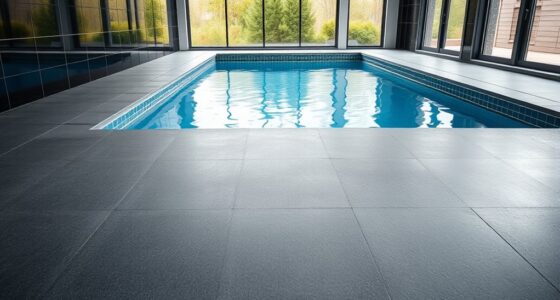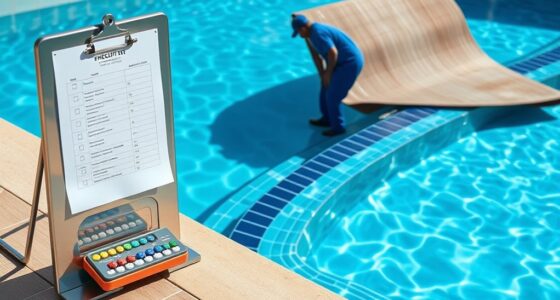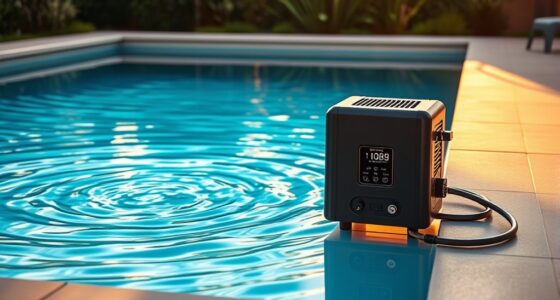Before installing your endless pool, you’ll need to check local zoning laws for setbacks and restrictions, obtain any necessary building permits, and verify your plans meet safety standards like fencing and electrical codes. Make sure to factor in property line setbacks, water management rules, and HOA regulations if applicable. Inspections ensure everything complies before you start. Want to avoid surprises? Continue for detailed steps to smoothly navigate permits and codes in your area.
Key Takeaways
- Check local zoning laws and property setbacks before installing an endless pool.
- Obtain necessary building permits, site plans, and contractor approvals from local authorities.
- Ensure electrical and plumbing installations meet safety codes, including GFCI outlets and proper drainage.
- Install safety features like fencing, barriers, and self-closing gates per pool safety standards.
- Review homeowners’ association rules and environmental regulations to ensure compliance and avoid penalties.
Understanding Local Zoning Regulations

Understanding local zoning regulations is essential because they determine how you can develop or modify property in your area. Before installing an endless pool, you need to know if your property zoning allows such structures. Zoning rules can restrict pool placement, size, and setbacks from property lines, roads, or neighboring properties. Some zones might prohibit certain uses or require specific setbacks and fencing. Failing to comply can lead to fines, orders to remove the pool, or legal issues. Check with your local planning department or zoning office to review zoning maps and regulations. Doing this upfront saves you time and money and helps ensure your project aligns with community standards. Being well-informed about zoning helps you plan effectively and avoid surprises during installation. Additionally, understanding permitting requirements can help streamline the approval process and prevent delays.
Building Permits and Application Process

Before you begin your project, it’s important to know if you meet the permit eligibility criteria. Next, you’ll need to follow the proper steps to submit your application correctly. Understanding these points helps guarantee a smooth and efficient permit process.
Permit Eligibility Criteria
To qualify for a building permit, you must meet specific eligibility criteria set by your local jurisdiction. These criteria guarantee your project complies with safety and zoning standards. First, your property must adhere to local zoning laws, including setbacks and land use restrictions. Second, your plans should meet structural and safety codes, demonstrating proper construction methods. Third, you need to provide detailed project documentation, such as blueprints and specifications. Fourth, your property must be free of unresolved code violations or outstanding permits. Meeting these requirements shows your project aligns with regulations, making it eligible for approval. Ensuring you meet these criteria helps streamline the permit process and avoids delays or rejections.
Application Submission Steps
Are you ready to submit your building permit application? First, gather all required documents like site plans, contractor info, and permits. Then, complete the application form accurately. Next, submit your paperwork to the local building department either online or in person. Be prepared for review and possible questions. To help, here’s a quick overview:
| Step | Action | Tips |
|---|---|---|
| Prepare Documents | Gather plans, permits, info | Double-check for completeness |
| Complete Application | Fill out forms accurately | Use clear, legible handwriting |
| Submit & Follow Up | Deliver to department, track status | Keep copies and note deadlines |
Following these steps ensures a smooth process for your Endless Pool installation permit. Additionally, understanding building codes can help prevent delays during approval.
Safety Standards and Pool Codes

Safety standards and pool codes are essential to guarantee that swimming pools are safe for everyone. They set clear guidelines to prevent accidents and ensure proper installation. When planning your endless pool, consider these key requirements:
Safety standards and pool codes help ensure your pool is safe and compliant.
- Fencing and barriers: Install barriers to restrict access and prevent unsupervised entry.
- Proper fencing height: Ensure fences are at least 4 feet tall, with self-closing gates.
- Electrical safety: Use GFCI outlets and proper wiring to prevent electrical hazards.
- Drain covers: Equip your pool with compliant drain covers to avoid entrapment risks.
Adhering to these standards not only keeps users safe but also helps you meet local regulations. Always verify specific codes in your area before starting your installation.
Setback Requirements and Property Lines

Before installing your pool, it’s important to be aware of setback requirements and property lines. These regulations determine how close your pool can be to boundaries, structures, or neighboring properties. Failing to adhere to them can lead to fines, removal orders, or legal disputes. Check local codes to find specific distances; they often vary by municipality. To clarify, here’s a quick overview:
| Boundary Type | Minimum Distance Requirement |
|---|---|
| Property Line | 5-10 feet |
| Building/Structure | 10-15 feet |
| Neighboring Property | Varies (check local rules) |
Understanding these setbacks ensures your pool installation remains compliant and avoids future issues. Always verify with local authorities before proceeding. Additionally, property setbacks play a crucial role in ensuring your pool’s safety and legal compliance.
Electrical and Plumbing Regulations

Ensuring your pool’s electrical and plumbing systems meet local regulations is crucial for safety and compliance. Failure to do so can lead to hazards, fines, or having to redo work. Here’s what you need to check:
Ensuring your pool’s electrical and plumbing systems meet local codes is vital for safety and compliance.
- Verify electrical wiring adheres to the National Electrical Code (NEC), including GFCI protection.
- Use approved, waterproof electrical components rated for outdoor use.
- Ensure plumbing connections follow local codes regarding pipe size, pressure, and drainage.
- Hire licensed professionals for both electrical and plumbing installations to guarantee code compliance.
- Understanding industry trends can help you stay informed about updated safety standards and best practices.
Permits for Drainage and Water Management

Securing the necessary permits for drainage and water management is a critical step to guarantee your pool complies with local regulations and avoids costly fines or delays. These permits ensure your drainage system effectively manages runoff, prevents flooding, and protects neighboring properties. To obtain them, you’ll need to submit detailed plans showing how water will be directed away from your property and into approved drainage systems. Local agencies may require inspections during and after installation to verify compliance. Failing to obtain proper permits can lead to fines, orders to modify or remove your pool, or legal issues if drainage causes damage. Additionally, understanding home decor principles can help in designing surrounding landscape features that complement your pool area. Check with your city or county offices early in the planning process to understand specific requirements and avoid surprises later.
Environmental and Water Use Guidelines

Understanding local water regulations is vital to guarantee your project complies with legal standards. You also need to take into account environmental impact standards to protect natural resources effectively. Additionally, water discharge restrictions can affect how you manage runoff and wastewater, so knowing these rules helps prevent violations. Incorporating vibrational alignment techniques can also support a positive mindset during the planning process, ensuring a smoother approval journey.
Local Water Regulations
Local water regulations set important guidelines for how you can use and manage water resources in your area. Before installing your endless pool, you need to understand these rules to avoid issues. Typically, regulations include:
- Permits for water use or modifications to existing water systems.
- Restrictions on water withdrawal from local sources.
- Limits on discharges or runoff into public waterways.
- Requirements for water conservation practices.
Failing to comply can lead to fines, delays, or even removal of your pool. Check with your local water authority to see which rules apply to your property. Staying informed ensures your installation remains legal and eco-friendly, helping you enjoy your new pool without complications. Additionally, understanding water conservation practices can help reduce your environmental impact and ensure ongoing compliance.
Environmental Impact Standards
Environmental impact standards set essential guidelines to guarantee that your pool installation minimizes harm to ecosystems and conserves resources. These standards ensure your project follows sustainable practices, like reducing water and energy consumption. You’ll need to assess the site to prevent disruption of natural habitats. Selecting eco-friendly materials and efficient equipment helps lower your environmental footprint. Compliance with these standards also involves implementing measures to control runoff and prevent pollution. Adhering to local regulations is vital to avoid fines and delays. By planning with environmental impact in mind, you contribute to conservation efforts and promote responsible pool ownership. Remember, these guidelines aren’t just about legal compliance—they’re about protecting the environment for future generations while enjoying your new Endless Pool today.
Water Discharge Restrictions
Properly managing water discharge is a key part of ensuring your pool installation aligns with environmental standards. Many local regulations restrict how and where you can drain excess water, so you need to be aware of specific guidelines. Typically, these restrictions include:
- Ensuring discharges don’t flow into storm drains or natural water bodies.
- Avoiding discharges during heavy rain to prevent flooding.
- Using approved filtration or treatment systems before releasing water.
- Limiting the volume and frequency of water discharge to reduce environmental impact.
- Regularly updating your fraud detection software to counter new threats and ensure compliance with environmental regulations.
Inspection Procedures and Compliance Checks

How do inspectors determine if a project complies with all permit requirements? They start by reviewing your plans and permit documentation to guarantee everything aligns with local codes. During inspections, they examine the installation site, checking that the pool’s placement, electrical wiring, and plumbing meet safety standards. Inspectors look for proper grounding, secure structural support, and adherence to setback regulations. They may also verify that permits were obtained before beginning work and that any required signage or barriers are in place. If issues are found, they’ll document deficiencies and require corrections before approving your project. Additionally, home security systems can play a role in monitoring the safety of the installation area during and after construction. The goal is to ensure your endless pool is safe, legal, and built according to all applicable regulations, minimizing risks and ensuring long-term compliance.
Homeowners’ Association Rules and Restrictions

Are you aware that your homeowners’ association (HOA) may have specific rules and restrictions that impact your pool project? Before proceeding, check your HOA’s guidelines to avoid surprises. Here are four common restrictions you might encounter:
- Pool Placement: Restrictions on how close the pool can be to property lines or structures.
- Aesthetic Rules: Limits on pool design, fencing, or landscaping to match neighborhood standards.
- Noise Regulations: Rules about noise levels during installation or use.
- Usage Restrictions: Limits on pool hours or ongoing maintenance requirements.
- Attention in Planning: Ensuring full attention to regulations can prevent issues and foster creative problem-solving in your project.
Reviewing these rules early guarantees your project stays compliant and avoids costly modifications or disputes. Always communicate with your HOA to clarify any uncertainties before moving forward.
Tips for Navigating Permit Approval Processes

To get your permit approved smoothly, you need to understand local regulations and requirements. Make sure you gather and prepare all the necessary documentation before submitting your application. Being organized and informed will help you navigate the process more efficiently.
Understanding Local Regulations
Understanding local regulations can seem overwhelming, but comprehending the approval process is essential for a smooth project. To navigate this effectively, start by:
- Research your city or county’s zoning laws to see if pools are permitted in your area.
- Check setback requirements to ensure your pool’s placement complies.
- Verify restrictions on pool size and height, which vary by jurisdiction.
- Review any homeowner association rules that might impose additional restrictions.
Preparing Necessary Documentation
Preparing the necessary documentation is a crucial step in guaranteeing your permit application moves smoothly through approval. Start by gathering detailed plans of your installation, including site diagrams, dimensions, and safety features. Obtain any required engineering reports or structural analyses if needed. Keep copies of your property deeds, zoning approvals, and previous permits to verify compliance. Check with your local permitting office for specific document requirements, as they can vary. Organize all paperwork neatly and ensure forms are complete and accurate. Providing clear, thorough documentation minimizes delays and shows you’re prepared. If you encounter unfamiliar terms or procedures, don’t hesitate to ask for guidance. Being proactive and meticulous in your documentation sets a positive tone for a swift approval process.
Frequently Asked Questions
How Long Does the Permit Approval Process Typically Take?
The permit approval process usually takes about two to four weeks, but it can vary depending on your local regulations and the complexity of your project. You should submit all required documents promptly and verify your plans meet zoning and safety standards. Staying in contact with your local permitting office helps speed things up. Be patient, and check in regularly to track your application’s progress.
Are There Specific Permits Required for Indoor vs. Outdoor Pools?
Of course, there are different permits for indoor and outdoor pools—because your city loves to keep things interesting. For outdoor pools, you’ll likely need a building permit and possibly a zoning approval, especially if you’re close to property lines. Indoor pools might require ventilation and electrical permits. So, don’t assume one permit covers both; check your local regulations because, surprise, they love to keep you on your toes!
What Penalties Exist for Installing Without Proper Permits?
If you install an endless pool without the proper permits, you could face hefty fines, forced removal, or legal action. Building without permits can also cause issues with insurance claims and property resale. Local authorities prioritize safety and code compliance, so neglecting permits risks violations that can delay your project or lead to costly penalties. Always get the necessary approvals beforehand to avoid these complications and ensure your pool is legally compliant.
Do Permits Cover Maintenance and Future Upgrades?
Permits typically don’t cover maintenance or future upgrades. They focus on initial installation compliance with safety, zoning, and building codes. Once your pool is installed legally, you’re responsible for ongoing upkeep and any upgrades. However, if future modifications require additional work or change the structure, you may need new permits or approvals. Always check local regulations to make sure you stay compliant during maintenance or upgrades.
Can Permits Be Transferred if I Sell My Property?
Yes, permits can usually be transferred when you sell your property, but it depends on your local regulations and the specific permit type. You should check with your city or county office to confirm their transfer policies. Keep in mind, some permits might require reapplication or additional approval, especially if there have been changes in codes or standards since you first obtained it. Always communicate with local authorities to ensure a smooth transfer process.
Conclusion
So, before you plunge into installing that endless pool, remember—your backyard isn’t just a personal oasis; it’s a neighborhood soap opera waiting to happen. Steering through permits and codes might seem like a chore, but think of it as giving your pool a VIP pass to stay out of legal hot water. Follow the rules, get approved, and soon you’ll be splashing happily—just don’t forget to invite the neighbors for the first ‘official’ swim!









